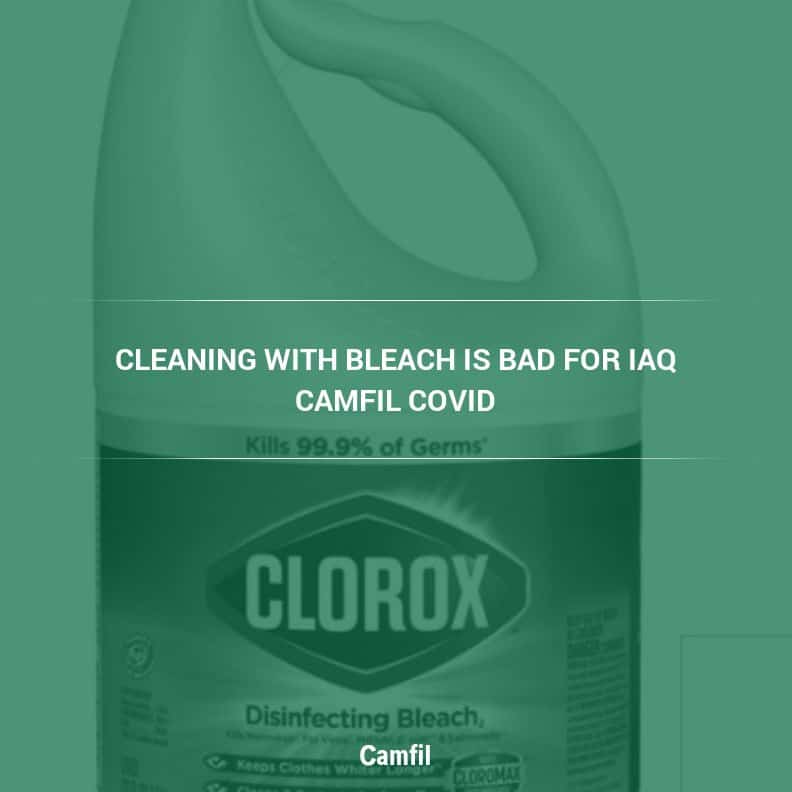Read about a Camfil Canadian study that found using bleach indoors can adversely affect health and what you can do about it.
Indoor Air Quality and Health
According to the EPA, Indoor Air Quality (IAQ) refers to air quality within and around buildings and structures. Because indoor air pollutants can result in both short- and long-term health effects, IAQ is an important metric in protecting the health of building occupants.
Some short-term effects of indoor air pollutants include eye irritation, nose, throat, headaches, dizziness, and fatigue. Longer-term health effects include respiratory diseases, heart disease and cancer. Babies, young children, the elderly, and those with compromised immune systems are especially vulnerable to exposure to indoor pollutants.
The Chemical Volatility of Bleach
Bleach has been commonly used as an indoor cleaning and disinfectant agent for many generations, but its chemical volatility makes it a potential health threat when used incorrectly. Bleach cleaning products contain sodium hypochlorite (NaOCl), which can emit chlorine-containing compounds such as hypochlorous acid (HOCI) and chlorine gas (Cl2). These vapors can rapidly accumulate in a poorly ventilated indoor environment.
The vapors can then interact with volatile organic compounds (VOCs) from other household chemicals and personal care products, posing a significant threat to human health. The most common would be terpenes like α-pinene, which provides that familiar ‘pine fresh’ scent and limonene, which is responsible for the bright citrus scent found in so many household products.
Furthermore, chlorine-derived compounds like HOCl and Cl2 can break down when exposed to any kind of light, resulting in hydroxyl radical and a chlorine atom. These atoms, in turn, react with other compounds to form particulate matter known as secondary organic aerosols (SOAs). Exposure to SOAs can result in irritation to eyes, nose, and throat, as well as cause headaches and nausea. Longer-term exposure can even result in lung damage. SOA atoms can decrease phagocytic movement in the lungs, which means cells are not ingesting unsafe particles or other microscopic organisms as they should.
All these indoor compound pollutants have been linked to respiratory problems and other adverse health effects. Ventilation, or the lack thereof, is clearly a factor in how much these indoor pollutants accumulate when used.
A Canadian Study on the Health Effects of Using Bleach
Researchers from the University of Toronto found that the particles from bleach combine with other indoor particles to form airborne particulate matter that may be harmful if inhaled. The study was published in the American Chemical Society Environmental Science and Technology journal.
The Canadian research team headed by chemist Cheng Wang wanted to ascertain whether limonene and bleach vapors, at concentrations normally found in indoor environments, might react with each other to produce SOAs under light and dark conditions. The team found that chlorine gas and hypochlorous acids from the bleach and limonene quickly reacted and created VOCs in the dark. These unstable compounds further formed SOAs once exposed to artificial or natural light.
It was the first study regarding the reaction of hypochlorous acid compounds and chlorine gas from bleach products with limonene and other VOCs. The report stated that the study would help “improve the understanding of the impact of bleach cleaners on indoor air quality.” The study also acknowledged that the composition and possible health effects of these compound particulates from bleach products needed to be studied further. However, the conclusion was that exposure to these compounds could be hazardous to the health of any person involved in cleaning activities.
Recommendations When Using Bleach
Professor Wang, the lead author of the study, recommended that anyone using bleach products indoors should do so with all windows opened. This would allow for better indoor ventilation and thus improved IAQ. It also decreases the inhalation of these harmful compound chemicals. He further recommended that people not mix chemicals when doing indoor cleaning or disinfecting.
Improve Your Indoor Air Quality
Opening windows may not always be the most effective way to improve your indoor air quality, especially during cold or bad weather. That is why your household or office may benefit from the use of air cleaners and air purifiers that use both high efficiency air filters to capture small particles out of the air and molecular filters to control VOCs in the air. These ventilation systems can complement your existing ventilation system and ensure a healthier living or working environment when using bleach and other cleaning products. These air cleaners and purifiers can also help reduce dust and other harmful particles that may accumulate indoors.
Camfil USA has more than 50 years of experience designing and building air filtration systems for households and office buildings. Get in touch with our USA local air filtration team to learn more about our air filter solutions today.
The post Cleaning with Bleach Is Bad for Indoor Air Quality IAQ appeared first on Air Filters for Clean Air.

